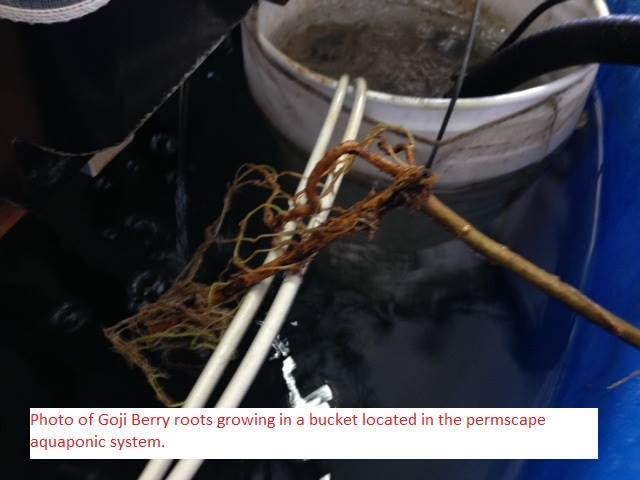


|
Commenced:
|
01/07/2014 |
|---|---|
|
Submitted:
|
09/01/2016 |
|
Last updated:
|
23/03/2017 |
|
Location:
|
Phoenixville, Pennsylvania, USA, Phoenixville, PA, US |
|
Phone:
|
email [email protected] |
|
Website:
|
http://www.permscape.com |
|
Climate zone:
|
Cool Temperate |
(projects i'm involved in)
Back to Aquaponics and Aquaculture Perennial Garden
Project: Aquaponics and Aquaculture Perennial Garden
Posted by John Stevenson about 8 years ago
The Lycium barbarum grows a fruit commonly called Goji berries (also called wolfberries). They are a very popular superfood. The berries have been eaten for thousands of years but have only become popular in the USA over the last decade or so.

They are a fat free, low calorie food rich in phytonutrients, vitamins (A,B2,C) and trace minerals. They also contains essential amino acids, calcium, iron, potassium, protein, and selenium.

We grow them outside in the soil as well as in the aquaponics system.
Some are raised in a Dutch bucket system filled with expanded clay media. This is fed with a constant drip from the fish tank below. In 2016 the Goji berries fruited in the bucket system with the roots in the water. They did equally well in the Dutch bucket system.

Tilapia waste generates the inputs needed to successfully grow Goji Berries in the permscape aquaponics system.

Another method that was successful for us was to completely submerge the plant roots in a bucket located inside of the fish tank of the aquaponics system.

The roots of the goji are harvesting the nitrogen from the fish tank and feeding the plant. This particular Goji was put in the bucket as a cutting.

As anticipated, we were able to expand production in 2016. The new plants will be put to good use in the permaculture food forest we are tasked with completing in 2017 - 2018.
https://permacultureglobal.org/projects/2870-permscape-permaculture-food-forest-oasis-and-education-center
We fed the excess berries from our 2016 harvest to the fish. They gobbled them up. Using excess fruit to create fish protein is a nice trade.
The Goji Berries outside are companion plants for our fruit trees. Pictured below is Goji with our Cherry Tree.

This Goji lives with our Cornelian Cherry tree, pineberries,wineberry, and Ginko. It is thriving in one of our mature Hugelkultur beds.
Needless to say there were quite a few grown in our yard. We are hoping for a bountiful Goji berry harvest in 2017.
Goji Berries growing with Comfrey, Rhubarb, Strawberry, and Blackberry under the Cherry Tree in the same small space.

That is the update for 2016. We will have more photos and information to share this spring.
You must be logged in to comment.
Note: The various badges displayed in people profiles are largely honesty-based self-proclamations by the individuals themselves. There are reporting functions users can use if they know of blatant misrepresentation (for both people and projects). Legitimacy, competency and reputation for all people and projects can be evidenced and/or developed through their providing regular updates on permaculture work they’re involved in, before/after photographs, etc. A spirit of objective nurturing of both people and projects through knowledge/encouragement/inspiration/resource sharing is the aim of the Worldwide Permaculture Network.
 |
MemberA member is a permaculturist who has never taken a PDC course. These cannot become PDC teachers. Members may be novice or highly experienced permaculturists or anywhere in between. Watch their updates for evaluation. |
|---|---|
  |
Permaculture MatchmakerOne of these badges will show if you select your gender and the "I'm single, looking for a permaculture partner" option in your profile. |
 |
PDCPeople who claim to have taken a Permaculture Design Certificate (PDC) course somewhere in the world. |
 |
PDC VerifiedPeople who have entered an email address for the teacher of their PDC course, and have had their PDC status verified by that teacher. Watch their updates for evaluation. |
 |
PRI PDCPeople who’ve taken a Permaculture Research Institute PDC somewhere in the world. |
 |
PDC TeacherPeople who claim to teach some version of PDC somewhere in the world. |
 |
PRI TeacherWith the exception of the ‘Member’ who has never taken a PDC, all of the above can apply to become a PRI PDC Teacher. PRI PDC Teachers are those who the PRI recognise, through a vetting board, as determined and competent to teach the full 72-hour course as developed by Permaculture founder Bill Mollison – covering all the topics of The Designers’ Manual as well as possible (i.e. not cherry picking only aspects the teacher feels most interested or competent in). Such teachers also commit to focussing on the design science, and not including subjective spiritual/metaphysical elements. The reason these items are not included in the PDC curriculum is because they are “belief” based. Permaculture Design education concerns itself with teaching good design based on strategies and techniques which are scientifically provable. PRI PDC Teachers may be given teaching and/or consultancy offerings as they become available as the network grows. |
 |
Aid WorkerThe individual with this badge is indicating they are, have, or would like to be involved in permaculture aid work. As such, the individual may or may not have permaculture aid worker experience. Watch their updates for evaluation. |
 |
ConsultantThe individual with this badge is indicating they are, have, or would like to do paid permaculture design consultancy work. As such, the individual may or may not have permaculture consultancy experience. Watch their updates for evaluation. |
 |
Community ProjectCommunity projects are projects that help develop sustainable community interaction and increase localised resiliency. |